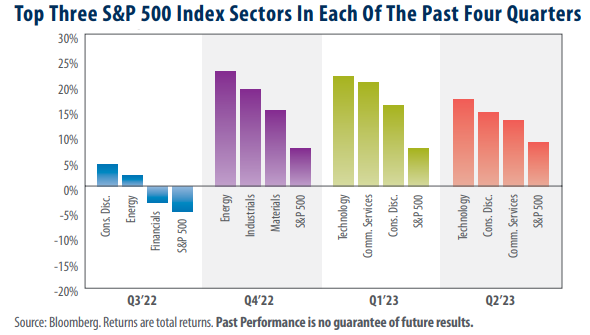
View from the Observation Deck
One of the most common questions we field on an ongoing basis is the following: What are your favorite sectors? Today’s blog post is one that we update on a quarterly basis to lend context to our responses. Sometimes the answer is more evident than at other times, and sometimes it only makes sense via hindsight. While the above chart does not contain yearly data, since 2005, only two sectors in the S&P 500 Index have been the top-performer in back-to-back calendar years. Information Technology was the first, posting the highest total return in 2019 (+50.29%) and 2020 (43.89%). Energy was the second, posting the highest total return in 2021 (54.39%) and 2022 (65.43%), according to Bloomberg.
• The top-performing sectors in Q2’23 were as follows (total returns): 17.20% (Technology), 14.58% (Consumer Discretionary), and 13.07% (Communication Services). The total return on the S&P 500 Index was 8.74%. The other eight sectors generated total returns ranging from 6.49% (Industrials) to -2.53% (Utilities).
• By comparison, the top-performing sectors in Q2’22 were as follows (total returns): -4.62% (Consumer Staples), -5.09% (Utilities) and -5.23% (Energy). The worst-performing sectors for the period (total return) were: -26.16% (Consumer Discretionary), -20.71% (Communication Services) and -20.24% (Information Technology).
• Recall that fears of a global banking crisis were running high in Q1’23. In the U.S., investors were grappling with the fallout of the second largest bank failure in the nation’s history. Meanwhile, the Swiss government took action to broker the sale of Credit Suisse, its second largest bank at the time. Fast-forward to Q2’23, and the global banking crisis appears to have been averted. Additionally, a wave of positive economic data likely relieved concerns regarding economic growth in the U.S. Notably, in Q2’23, the yields on the 2-year and 10-year Treasury Notes rose by 87 and 37 basis points, respectively (not in chart). As many investors know, bond prices and yields move in opposite directions. From our perspective, rising Treasury yields could be reflective of investors’ willingness to take on increased risk in the equity markets amidst easing headwinds to growth.
• Advancements in artificial intelligence (AI) have proven to be a catalyst to the S&P 500 Information Technology Index this year. Year-to-date (YTD) through 6/30/23, the total return for the index stood at 42.77%. For comparison, the Communication Services and Consumer Discretionary sectors posted total returns of 36.24% and 32.97%, respectively, over the same period.
• The S&P 500 posted a YTD total return of 16.88% through 6/30/23. Seven of the 11 major sectors that comprise the index were positive on a total return basis while four were negative during the time frame.
• Click here to access the post featuring the top-performing sectors in Q3’21, Q4’21, Q1’22 and Q2’22.
Takeaway
As we can observe from today’s chart, while the top-performing sectors often vary from quarter to quarter, Technology stocks maintained an edge over their peers in both Q1 and Q2 of 2023. From where we stand, easing fears of a global banking contagion as well as developments in AI may have contributed to higher revenues for Technology companies in the first half of the year. In 2021 and 2022, the companies that comprise the S&P 500 Information Technology Index saw revenue growth of 14.68% and 13.64%, respectively. For comparison, revenue growth for the 2018, 2019, and 2020 calendar years stood at 11.55%, 16.63%, and 5.30%, respectively. To be fair, it is not all good news when it comes to the Technology sector. The price-to-earnings (P/E) ratio of the S&P 500 Technology Index stood at 30.08 at the close of 7/5/23, well above its 10-year monthly average of 23.88 over the 10-year period ended the same date. Additionally, a total of 830 tech companies laid off nearly 213,000 employees globally year-to-date through 7/5/23. That said, from a total return perspective, Technology stocks have had an impressive first half of the year, outperforming each of their peers. We look forward to seeing what the data reveals next quarter.



